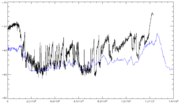
NGRIP
Encyclopedia

Greenland
Greenland is an autonomous country within the Kingdom of Denmark, located between the Arctic and Atlantic Oceans, east of the Canadian Arctic Archipelago. Though physiographically a part of the continent of North America, Greenland has been politically and culturally associated with Europe for...
(75.1 N, 42.32 W, 2917 m, ice thickness 3085). Drilling began in 1999 and was completed at bedrock
Bedrock
In stratigraphy, bedrock is the native consolidated rock underlying the surface of a terrestrial planet, usually the Earth. Above the bedrock is usually an area of broken and weathered unconsolidated rock in the basal subsoil...
in 2003 http://news.bbc.co.uk/1/hi/sci/tech/3090279.stm. The cores
Ice core
An ice core is a core sample that is typically removed from an ice sheet, most commonly from the polar ice caps of Antarctica, Greenland or from high mountain glaciers elsewhere. As the ice forms from the incremental build up of annual layers of snow, lower layers are older than upper, and an ice...
are cylinders of ice four inches in diameter that were brought to the surface in 3.5-meter lengths. The NGRIP site was chosen to extract a long and undisturbed record stretching into the last glacial, and it succeeded. The site was chosen for a flat basal topography
Topography
Topography is the study of Earth's surface shape and features or those ofplanets, moons, and asteroids...
to avoid the flow distortions that render the bottom of the GRIP
Greenland ice core project
The Greenland Ice Core Project was a multinational European research project, organised through the European Science Foundation. Funding came from 8 nations , and from the European Union...
and GISP
Greenland Ice Sheet Project
The Greenland Ice Sheet Project was a decade-long project to drill ice cores in Greenland that involved scientists and funding agencies from Denmark, Switzerland and the United States. Besides the U.S. National Science Foundation, funding was provided by the Swiss National Science Foundation and...
cores unreliable. Unusually, there is melting at the bottom of the NGRIP core - believed to be due to a high geothermal heat flux locally. This has the advantage that the bottom layers are less compressed by thinning than they would otherwise be: NGRIP annual layers at 105 kyr age are 1.1 cm thick, twice the GRIP thicknesses at equal age.
The NGRIP record helps to resolve a problem with the GRIP and GISP2 records - the unreliability of the Eemian Stage portion of the record. NGRIP covers 5 kyr of the Eemian, and shows that temperatures then were roughly as stable as the pre-industrial Holocene
Holocene
The Holocene is a geological epoch which began at the end of the Pleistocene and continues to the present. The Holocene is part of the Quaternary period. Its name comes from the Greek words and , meaning "entirely recent"...
temperatures were. This is confirmed by sediment
Sediment
Sediment is naturally occurring material that is broken down by processes of weathering and erosion, and is subsequently transported by the action of fluids such as wind, water, or ice, and/or by the force of gravity acting on the particle itself....
cores, in particular MD95-2042 http://www.worldchanging.com/archives/001199.html.
In 2003, NGRIP recovered what seem to be plant remnants nearly two miles below the surface, and they may be several million years old. http://www.glaciology.gfy.ku.dk/ngrip/index_eng.htm
"Several of the pieces look very much like blades of grass or pine needles," said University of Colorado at Boulder geological sciences Professor James White, an NGRIP principal investigator. "If confirmed, this will be the first organic material ever recovered from a deep ice-core drilling project," he said.
External links
The original web page of the NGRIP project with field diaries and pictures. The page has not been updated since the drilling was completed:- http://www.glaciology.gfy.ku.dk/ngrip/index_eng.htm
The NGRIP project was run by an international consortium of scientists, and drilling and logistics were managed by what is now called Centre for Ice and Climate at the Niels Bohr Institute, University of Copenhagen, Denmark. This research centre maintains a web page about ice core research:
- http://www.iceandclimate.nbi.ku.dk/research/drill_analysing/history_drilling/search_eemian/

